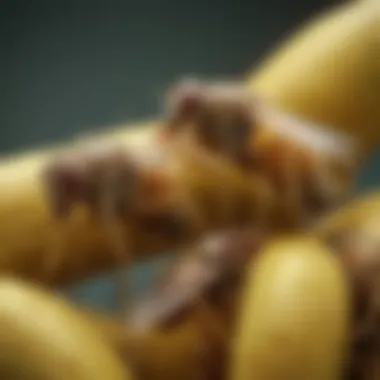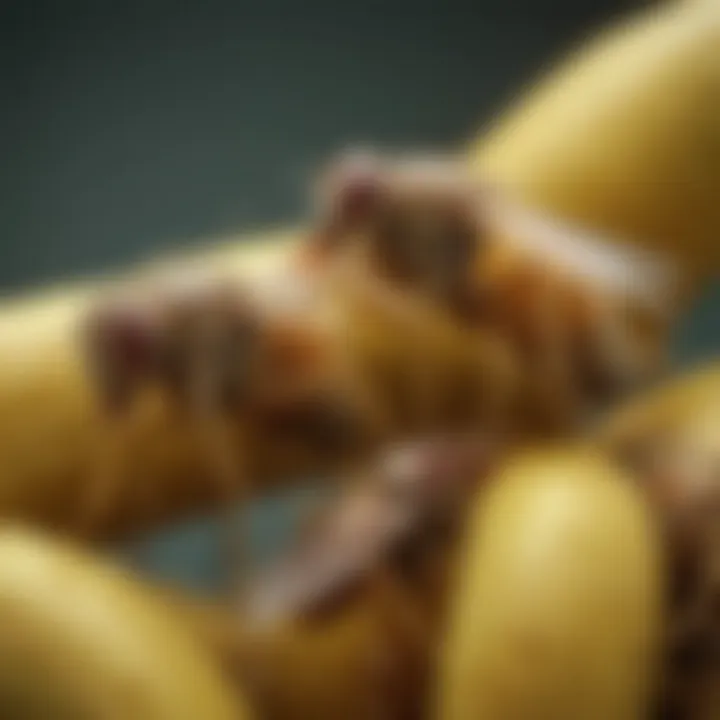Effective Strategies to Eliminate Fruit Flies


Intro
Fruit flies, or Drosophila melanogaster, are more than just pesky nuisances in the kitchen. They breed quickly, and their presence often signals deeper issues related to food storage and cleanliness. Understanding their biology and behavior is essential for effective eradication. This article will delve into practical strategies for eliminating fruit flies, from identifying their breeding grounds in your home to implementing both natural and chemical solutions.
Through this comprehensive guide, we aim to provide a clear and evidence-based approach to controlling these unwelcome visitors. Armed with knowledge and effective methods, you can reclaim your living space from fruit flies.
Understanding Fruit Flies
Understanding fruit flies is vital to effectively managing them in your home. These insects are not just an irritant; they can indicate deeper sanitary issues within a household. Recognizing their behaviors and life cycles can empower homeowners to take action before an infestation escalates. The initial step in any control strategy is to understand what you are dealing with. This knowledge simplifies the process of identifying attractants and breeding grounds, ultimately guiding the choice of appropriate management techniques.
Biology and Life Cycle
Fruit flies, predominantly Drosophila melanogaster, exhibit a short life cycle that can range from a few days to a couple of weeks, depending on environmental factors like temperature and food availability. A female fruit fly can lay hundreds of eggs in a suitable environment. Once these eggs hatch, they rapidly develop into larvae, feeding on available organic matter. They eventually pupate and emerge as adults, ready to reproduce. The rapid reproduction rate means that even a small number of fruit flies can quickly become a significant problem if left unchecked. Understanding this life cycle is fundamental. It indicates why consistent monitoring and removal of breeding sites are essential in thinning their population.
This cycle varies across species. For example, some species are attracted to overripe fruits, while others might thrive in environments with fermented materials. Thus, knowing their biology helps homeowners anticipate their presence and take preventative actions.
Common Species of Fruit Flies
While many species exist, the most common fruit flies found in households include Drosophila melanogaster, Drosophila simulans, and Drosophila funebris.
- Drosophila melanogaster: This is the classic model organism, often seen in kitchens, particularly where fruits and vegetables are stored.
- Drosophila simulans: Very similar to Drosophila melanogaster, it often prefers slightly different environments and can be found near compost heaps.
- Drosophila funebris: This type has a notorious reputation for appearing in decaying organic materials.
By understanding these specific species, homeowners can learn about their distinct habits and preferences, which can be beneficial in implementing targeted control measures.
"Knowledge about fruit flies not only helps in getting rid of them but also prevents future infestations."
Overall, a solid grasp of fruit flies' biology and common species lays the groundwork for effective pest management strategies. Understanding their life cycle and the dynamics of various species highlights the importance of early intervention, the main component in ensuring a fruit-fly-free home.
Identifying Attractants
Understanding what attracts fruit flies to your premises is critical in formulating an effective eradication strategy. Fruit flies are primarily drawn to certain substances and environments, and by getting familiar with these elements, one can significantly reduce their prevalence. Identifying attractants not only helps in tackling existing infestations but also plays a significant role in preventing future occurrences. An informed approach allows for more targeted interventions and ultimately less frustration.
Common Food Sources
Fruit flies are particularly fond of ripened or overripe fruit and various fermenting foods. The sugars and organic compounds released during the decay process act as powerful lures. It is essential to understand that any food substance, particularly those high in sugar, can serve as an attractant.
Some of the most common sources include:
- Fruits: Bananas, apples, and tomatoes are particularly enticing.
- Vegetables: Soft or rotting vegetables can attract these pests as well.
- Fermenting liquids: This includes wine, vinegar, and even certain carbonated beverages that have gone flat.
- Spills and crumbs: Any sugary residue left on surfaces can also provide a feast for fruit flies.
Regularly checking food items and ensuring timely disposal of any spoiled produce can help mitigate this issue. Store items properly, using airtight containers whenever possible. Regular waste checks of items in trash bins, especially those containing food waste, are vital in minimizing potential attractants.
Environmental Factors


In addition to food sources, environmental conditions can play a significant role in attracting fruit flies. They thrive in warm, damp environments where spoiled substances may be present.
Key environmental factors to consider include:
- Humidity levels: High humidity can lead to faster decomposition of food, creating a potential breeding ground.
- Temperature: Warmer weather tends to accelerate fruit fly development, heightening the risk of infestation.
- Sanitation: Areas that lack regular cleaning can accumulate residues and organic matter that attract these pests.
- Access points: Open windows and doors, or gaps in infrastructure, may serve as entry points, allowing fruit flies to invade your home.
Reducing the availability of food and suitable environments for fruit flies can significantly lower the risk of an infestation. No breeding grounds mean fewer fruit flies in your home.
Understanding these attractants is the first step in developing a comprehensive strategy to combat fruit flies. By eliminating conducive conditions and sources, you lay a strong foundation for successful pest management.
Preventive Measures
Preventive measures play a crucial role in controlling fruit fly populations in the home. Understanding how to limit conditions conducive to their proliferation is essential for effective management. By integrating proactive strategies into daily routines, homeowners can significantly decrease the chances of infestations. This segment will delve into specific tactics that can be applied to create an environment less appealing to fruit flies.
Regular Cleaning Regimens
Maintaining a clean living space is vital in discouraging fruit flies. Regular cleaning ensures that potential breeding grounds are minimized. It is advisable to take a systematic approach to cleaning, targeting high-risk areas like the kitchen and dining spaces. Here are some measures to consider:
- Wipe down surfaces frequently, particularly countertops, tables, and any spot where food is prepared or consumed.
- Empty trash cans regularly, and ensure that lids are secured tightly. Uncovered trash can become a breeding ground, attracting fruit flies.
- Clean spills promptly. Fruit flies are attracted to fermenting and decomposing materials. Hence, any juice or food residue should be cleaned quickly to avoid attracting these pests.
Additionally, employing a vacuum regularly can help eliminate adult flies, as well as larvae and eggs that may be present on surfaces.
Proper Food Storage
Food storage practices directly impact fruit fly infestations. Keeping food items securely stored can drastically reduce the likelihood of attracting these pests. Homeowners should follow these guidelines:
- Store ripe and cut fruits in the refrigerator as they tend to ferment quickly and thus attract fruit flies. Keep bananas, tomatoes, and avocados in covered containers or the fridge.
- Seal pantry items in airtight containers. Flour, grains, and dried fruits can be inviting to fruit flies if left open. Good sealing practices can create a barrier, preventing flies from accessing these foods.
- Use storage bags for leftovers to eliminate easy access to decomposing food. Ensure they are tightly sealed to prevent odors from escaping, which may attract fruit flies.
Proper food storage practices not only help in keeping fruit flies at bay, but they also promote overall kitchen hygiene.
Managing Compost and Waste
Composting is an excellent practice for sustainable living, but improper management can attract fruit flies. Here’s how to tackle this issue effectively:
- Cover compost bins at all times to limit access to fruit flies. Using a tightly fitted lid can help in maintaining a strong barrier against pests.
- Bury food scraps within the compost. Instead of leaving them exposed on top, burying scraps under layers of brown materials such as leaves or straw can reduce odors that attract flies.
- Regularly aerate the compost pile. This helps to control moisture levels, which can deter fly attraction. A dry compost bin is less appealing to fruit flies than one that is overly moist.
Managing compost properly promotes healthy decomposition while reducing the risk of attracting unwanted pests.
"Keeping your home clean and managing waste effectively can be pivotal in controlling fruit fly populations, ensuring a more pleasant living environment."
Implementing these preventive measures will create layers of protection against fruit flies. A combination of vigilance and good habits can significantly mitigate the risk of an infestation, leading to a more enjoyable living space.
Trapping Techniques
Trapping techniques play a vital role in managing fruit fly populations in homes. These strategies not only help capture existing flies but also prevent future infestations. Making use of traps can significantly reduce reliance on chemical solutions, promoting more natural pest control approaches. Trapping can be tailored to suit different environments, offering flexibility according to individual preferences or resources. The key is to select a method that aligns best with the living conditions and extent of the problem.


Homemade Traps
Homemade traps are often favored for their cost-effectiveness, simplicity, and use of easily available ingredients. By creating traps at home, individuals can control fruit fly populations without resorting to harsh chemicals.
Vinegar and Dish Soap Trap
The vinegar and dish soap trap stands out due to its accessibility and effectiveness. This method involves mixing apple cider vinegar with a few drops of dish soap in a bowl. The key characteristic of this trap lies in the vinegar's strong scent, which lures the flies in. Once attracted, the dish soap decreases the surface tension of the liquid, preventing the flies from escaping. This trap is a popular choice among many homeowners for its straightforward setup and efficacy.
However, one unique feature of this method is that it requires host ingredients and may need frequent replacement to maintain attractivity. While effective, it might not catch all flies if not consistently managed.
Wine Trap
On the other hand, the wine trap utilizes the sweet aroma of fermenting wine to attract fruit flies. To set it up, simply use an open bottle or glass of red wine. The key characteristic is its ability to draw flies in with its fermented scent, which is naturally appealing to many pests. This trap is celebrated for being an organic means of capturing flies.
One notable unique feature is its use of leftover wine, which reduces waste. However, the disadvantage is that it might not be as effective if the flies already have alternative food sources nearby.
Fruit Trap
The fruit trap operates on the principle of using overripe or rotten fruits to attract flies. The key characteristic is the use of fruit's natural sugars, which entice fruit flies effectively. This method is beneficial since it utilizes organic waste that might otherwise go discarded. It can draw flies in large numbers, making it an appealing choice for those dealing with significant infestations.
A unique feature of the fruit trap is the ability to customize it based on available fruits at home. However, it does have its disadvantages, mainly the need for regular checks and disposal of decomposing fruits, which may produce unpleasant odors over time.
Store-Bought Solutions
Store-bought solutions offer convenience for those who prefer ready-made options. These solutions often come in various forms, such as liquid sprays, sticky traps, and insecticidal baits. These products are generally designed after thorough testing and research, ensuring effectiveness against fruit flies. They can be useful for immediate and visible results, especially when other methods seem inadequate or slow to yield results. However, it is essential to consider the ingredients used in these products and their potential risks to the home environment and inhabitants.
Chemical Control Options
Chemical control options are often considered when dealing with fruit flies. While natural methods are effective, sometimes extra measures are necessary. Understanding these options is crucial for those who face infestations on a recurring basis. Chemical treatments can offer rapid results and may help in extreme situations where other methods fail.
Insecticides designed for fruit flies can effectively reduce their populations. They are formulated to target the pests during different life stages. However, it’s important to select the appropriate type to ensure effectiveness and safety. Many insecticides are readily available, both in stores and online. When applied correctly, these sprays can serve as a reliable frontline defense.
However, consideration must be given to possible side effects, both for humans and pets. Some chemicals have strong odors or may cause irritation. Therefore, chemical control should complement, rather than replace, preventive measures. Integrated pest management is key in handling fruit fly situations effectively.
Insecticides and Sprays
Insecticides come in various forms including sprays, baits, and foggers. Each serves a unique purpose and has different concentrations of active ingredients. Pyrethroids and neonicotinoids are commonly found in insecticides for fruit flies. They act by disrupting the nervous system of the insects. While the efficacy of these chemicals is high, they must be used judiciously. Key points to remember include:
- Read the label: Understand the active ingredient and follow instructions.
- Identify target areas: Spray on surfaces where fruit flies are congregating.
- Timing: Apply during the peak activity of fruit flies, often in warmer months.
Due to the sometimes immediate effects of insecticides, they can provide short-term relief. However, recurring infestations may require repeating treatments.
Safety Precautions
Using chemical control methods requires adherence to safety precautions. Protecting the health of all inhabitants is essential. Here are some guidelines to consider:


- Ventilation is crucial: Always ensure windows are open. This helps in dissipating harmful vapors.
- Use gloves and masks: Protect your skin and respiratory system by wearing appropriate gear.
- Keep children and pets away: Designate areas treated as off-limits until it is safe to return.
- Follow dosage: Never exceed recommended amounts. More does not always mean better.
"Chemical control options can be effective but should be managed with caution to prevent unintended consequences."
Lastly, while chemical treatments are often seen as a quick solution, sustainability must inform your approach. Consider integrating these methods with hygiene practices and natural traps. This creates a comprehensive strategy for long-term management of fruit flies.
Post-Infestation Strategies
Post-infestation strategies play a pivotal role in controlling and managing fruit fly populations once they have established themselves in a household. It is essential to address the issue promptly to prevent further complications. Understanding the extent of the infestation is crucial. By implementing a clear plan for assessment and long-term control, homeowners can ensure their efforts lead to a sustainable resolution.
Assessment of Infestation
Assessing the level of infestation is the first step toward effective management. The process involves several key elements:
- Visual Inspection: Begin with a thorough visual check of common areas where fruit flies gather. Focus on kitchens, pantries, and compost bins. Look for both adult flies and their larvae.
- Documentation: Keep detailed records of your findings. Note the dates of observations, the places where flies are most concentrated, and any potential breeding sources. This will aid in evaluating trends and effectiveness of control methods.
- Breeding Source Identification: Look for possible breeding sites. Common sources include overripe fruits, spilled liquids, and dirty dishes. Eliminate these attractants promptly.
An effective assessment helps in gauging the severity of the problem. It can indicate whether immediate action is necessary or if a less urgent response is adequate. This step is often overlooked but is critical for forming a comprehensive control strategy.
Long-Term Control Measures
Once you have assessed the infestation, it is vital to implement long-term control measures to prevent recurrence. Key strategies are:
- Continued Cleanliness: Maintaining a clean environment is the bedrock of prevention. Regular cleaning schedules should include wiping down surfaces, disposing of waste, and ensuring food items are sealed and stored properly.
- Monitoring Practices: Regular monitoring can catch any regrowth before it turns into a major challenge. Set up traps again periodically to ensure the population remains controlled.
- Nutritional Changes: Rethink how food is stored and consumed. For instance, fruits that spoil quickly should be consumed or discarded pur promptly.
- Improved Waste Management: Adjust your composting methods or waste disposal processes. If compost attracts flies, consider sealing it or choosing alternative locations away from living areas.
- Education: Finally, educating household members about preventing fruit fly attraction helps build a cohesive long-term strategy. Everyone should understand the importance of cleanliness and prompt action.
"An ounce of prevention is worth a pound of cure" - this holds especially true in the ongoing battle against fruit flies.
These long-term measures are not just to combat an existing infestation. They should be ingrained into daily routines to ensure that fruit flies and other pests remain at bay. Consistent assessment and adherence to these strategies will lead to a fruit fly-free environment, allowing everyone in the household, passionate about food, to enjoy their culinary experiences without worry.
Building a Fly-Free Environment
Creating a fly-free environment is essential for minimizing the presence and breeding of fruit flies in the home. This preventive approach not only focuses on immediate solutions but also emphasizes long-term strategies to sustain a clean and hygienic space. By fostering an environment that discourages fruit flies, homeowners can significantly reduce the risk of infestations in the future.
Lifestyle Adjustments
Adopting certain lifestyle adjustments can play a paramount role in keeping fruit flies at bay. Firstly, it is vital to be mindful about managing food waste effectively. This includes promptly disposing of overripe fruits, vegetables, and any other organic matter that can attract these pests. Furthermore, ensure that countertops and dining areas are regularly wiped clean to eliminate food residues that can serve as a breeding ground.
In addition to food management, consider implementing routine checks of household items such as recycling bins. Rinsing containers before disposal can eliminate remnants that otherwise may attract fruit flies. Investing in sealed storage containers can aid in keeping food items fresh while simultaneously reducing potential attractants.
Moreover, maintaining a dry environment is equally significant. Fruit flies thrive in moist conditions, so it is advisable to fix any leaks in plumbing and regularly check for damp spots around the home. Keeping drains clean and free of any organic buildup can also deter their presence.
Some people might overlook the impact of air circulation. Effective ventilation is crucial, as stagnant air can harbor moisture and create an inviting atmosphere for fruit flies. Utilizing oscillating fans or opening windows periodically can improve airflow and help maintain a less hospitable setting for pests.
Monitoring and Revisiting Procedures
Regularly monitoring your home is a necessary practice in ensuring it remains fruit fly-free. Schedule periodic assessments of various areas where fruit flies may breed, such as kitchens, pantries, and composting spots. This vigilance helps catch any signs of infestations early, allowing for timely intervention.
It is also advantageous to revisit prevention strategies every few months. Home environments evolve, and what may have been effective in the past might become less so due to changes in habits or new attractants. Therefore, reassessing your food storage techniques and cleanliness protocols ensures that you continue to combat potential infestations effectively.
Documentation can be a helpful tool. Keeping a log of cleaning schedules and preventive measures adopted provides clarity on what works. This detailed approach allows homeowners to refine their strategies and further reduce the chances of fruit fly return. Moreover, revisiting house adjustments may also help in uncovering areas previously ignored or new changes that could pose a threat.
"An ounce of prevention is worth a pound of cure." - This phrase rings true when it comes to managing fruit flies. A proactive stance can bring about long-lasting peace of mind.







